Submitted by Steve Irons on Thu, 20/06/2024 - 3:02pm
Nuclear Power Plants: Yesterday, in a news article, Peter Dutton, the Opposition Leader, announced a plan for nuclear energy, which includes seven nuclear power plants in various locations across Australia:
- Lithgow NSW
- Hunter Valley NSW,
- Latrobe Valley Vict,
- Tarong Qld,
- Callide Qld,
- Port Augusta SA, and
- Collie WA
ASSUMED NUCLEAR FISSION: If a meltdown occurs this is assumed to be similar to a minimum of a bomb of 475 kilotons.
NOTE: Populations quoted are purely indicators of probable impacts on people living around the nuclear facilities.
Lithgow NSW:
Lithgow Power Station (900 metres above sea level on the other side of the Blue Mountains in the Murray-Darling basin) NSW was an Australian power station built in 1928 to supply power to the NSW Government Railways, the small arms factory, Hoskins mine, and Lithgow council.
The power station was decommissioned in 1964.
Worst-case scenario: A meltdown here will destroy the old coal-fired Lithgow power station site and impact on Lithgow (20,724), Oberon (5,600) and Bathurst (46,619), maybe Blackheath (4,669), Katoombah (9,102) (NOTE: Katoombah is 1,017 metres above sea level), Hazelbrook (5,077), Springwood (8,475), etc. Previous meltdowns in Russia and Japan suggest the whole of Sydney (5,184,896) (only 143 km away) could be seriously impacted.
Water availability suggests this is a poor choice as the minimum requirements for potable water for ordinary operation don't exist in this area of the Murray-Darling and in crisis mode it is impossible to ship in sufficient water to keep the system cool, which makes meltdown even more likely here than in any other location that has unlimited access to clean potable water for some (most) operations, and access to the sea for saltwater for some (limited) operations. A serious no-goer! A complete mistake.
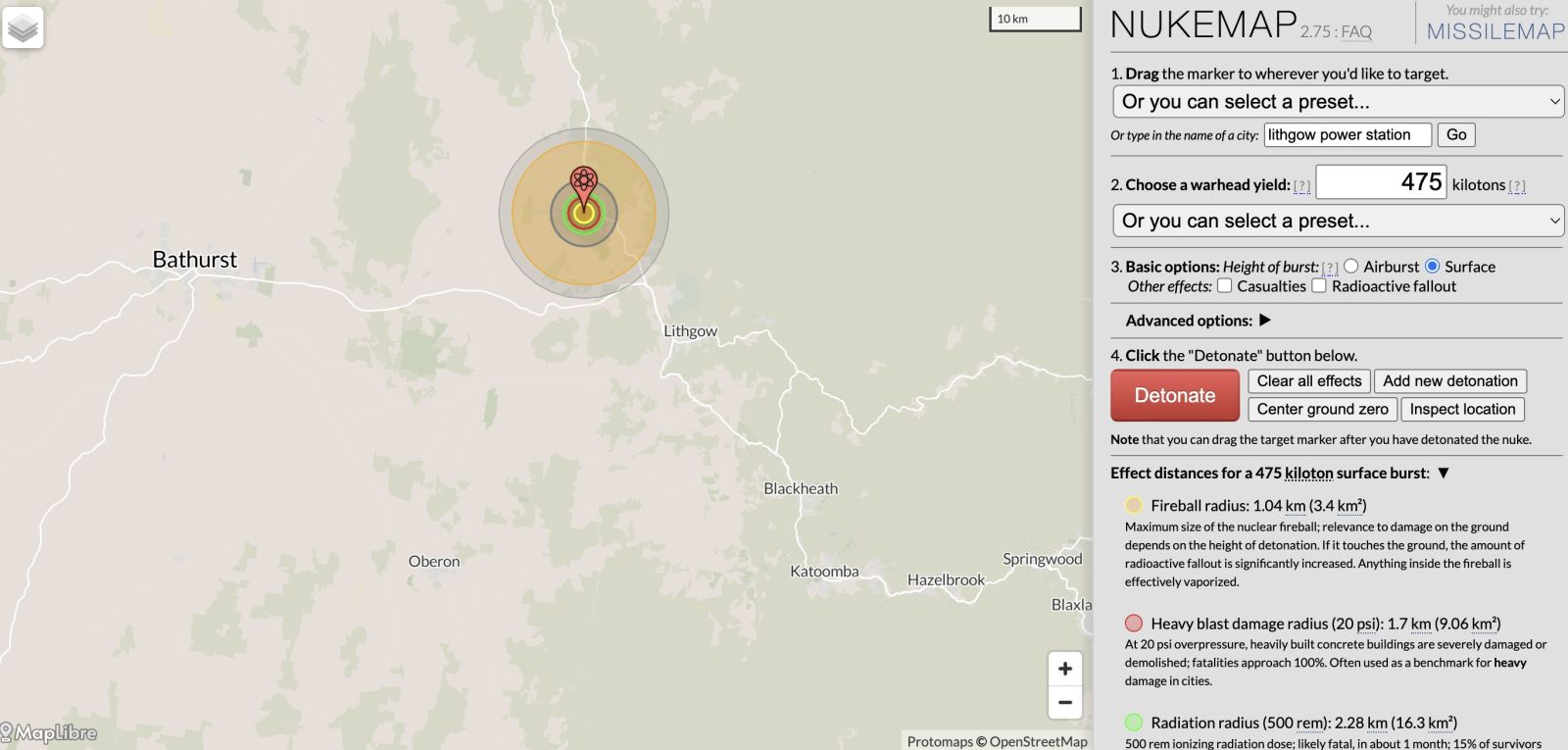
Hunter Valley NSW:
The Liddell Power Station in NSW is no longer in operation. The power station was decommissioned on April 28, 2023.
Worst-case scenario: A meltdown here will destroy the old Liddell coal-fired power station site and impact on Muswellbrook (10,901), Branxton (4,506), and Singleton (5,000), etc. Previous meltdowns in Russia and Japan suggest the whole of Newcastle (243 km away) (482,334) could be seriously impacted.
Water availability: This power station site is located on Lake Liddell but Lake Liddell was closed for public use in March 2016 after Naegleria fowleri, a brain-eating amoeba, was discovered in the lake. Heavy metals have been detected in Lake Liddell. This means that water availability suggests this is a poor choice as the minimum requirements for potable water for ordinary operation if taken out of the Hunter River will seriously impact on key requirements for important NSW agriculture being conducted in the Hunter Valley and in crisis mode sufficient saltwater from the sea to keep the system cool could be pumped uphill (lets assume 120 metres above sea level) from Newcastle (over 243 km), at significant cost, all of which means, this is a major no-goer, and with the Lake in its current state of disrepair and possible impact on human life probably a huge disaster waiting to happen.
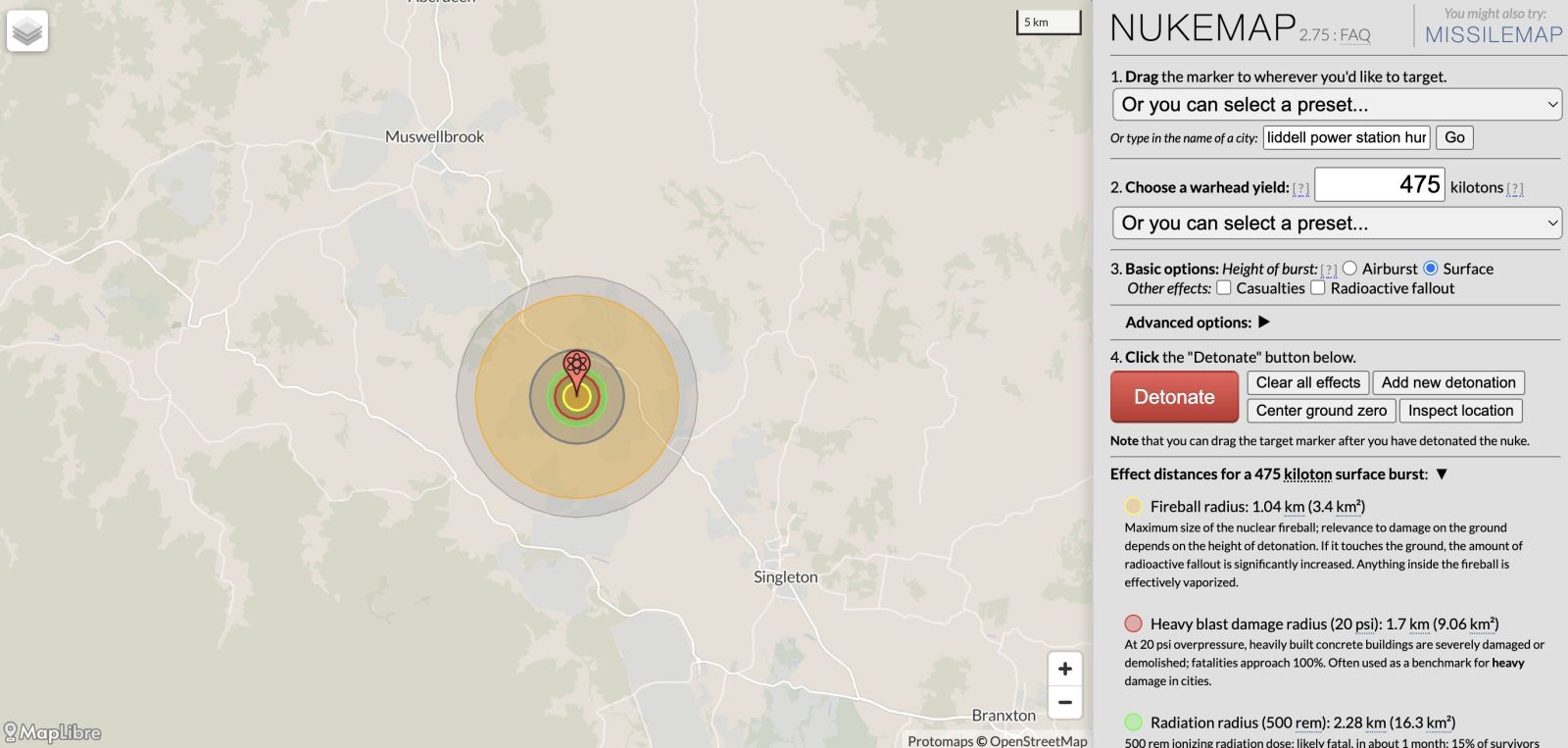
La Trobe Valley Vic.:
Loy Yang B Power Station is an essential baseload brown coal fired (lignite) power generator located 160 km east of Melbourne, Victoria in the Latrobe Valley.
Worst-case scenario: A meltdown here will destroy the old Loy Yang coal-fired power station site and this would be a direct hit to Traralgon (21,960 deaths) and further impact on Varragul (14,389), Heyfield (1,993), Maffra (5,384), Sale (19,000), Longford (1,497) and Leongatha (5,868), etc. Previous meltdowns in Russia and Japan suggest the whole of Melbourne (5,315,600) (only 160 km away) could be seriously impacted.
Water availability: Loy Yang is not located on a Lake. Water availability suggests that La Trobe River / Sheepwash Ck could provide minimum requirements for potable water for ordinary operation but this could have a serious impact on key requirements for important Vic. agriculture being conducted in the region and in crisis mode sufficient saltwater from the sea to keep the system cool could be pumped uphill (let's assume 200 metres above sea level) from the coast (let's assume 80 km from the east coast), at significant cost, which means that given the huge additional requirement for access to clean potable water for some (most) operations, and access to the sea for saltwater for some (limited) operations, this is likely to be a no-goer.
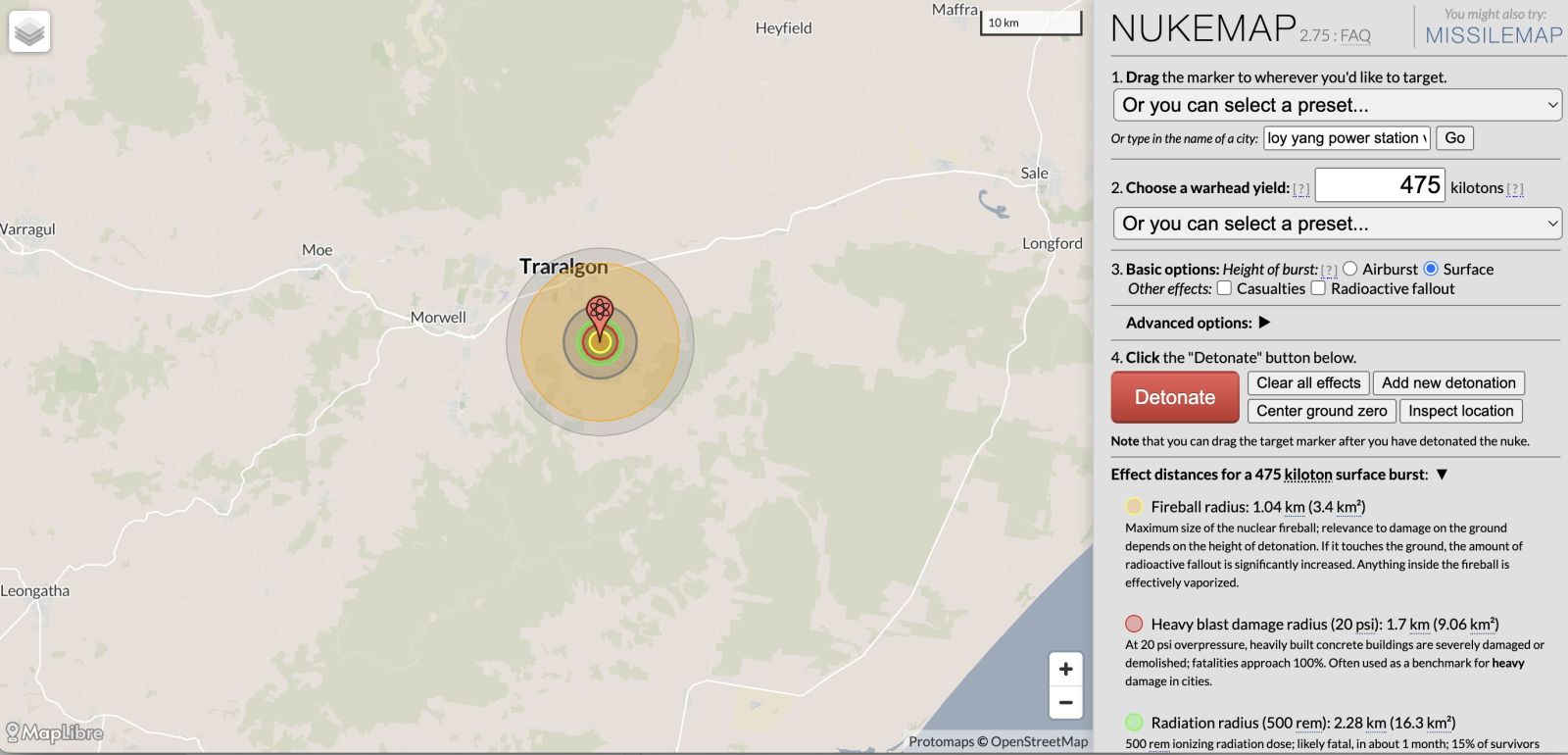
Tarong QLD.:
The Tarong power station in QLD was commissioned in 1984 and has been operational since then. The power station has undergone various upgrades and expansions, including the installation of a 150 MW grid battery in 2024.
Worst-case scenario: A meltdown here will destroy the old Tarong coal-fired power station site and a direct hit will take out Yarraman (1,720 deaths), and impact on Kumbia (301), and Blackbutt (836), etc. Previous meltdowns in Russia and Japan suggest the whole of Brisbane (only 137 km away) (2,536,449) could be seriously impacted.
Water availability suggests that Boyne River and two lakes nearby Lake Boondooma (Proston) and Lake Barambah, also known as Bjelke Petersen Dam, could provide minimum requirements for potable water for ordinary operation and impact on key requirements for important QLD agriculture being conducted in the region would be minimal and in crisis mode sufficient saltwater from the sea to keep the system cool could be pumped uphill (387m above sea level) from the coast (120 km), at significant cost, but not enough to render this site unworkable, all of which means this is probably a goer.
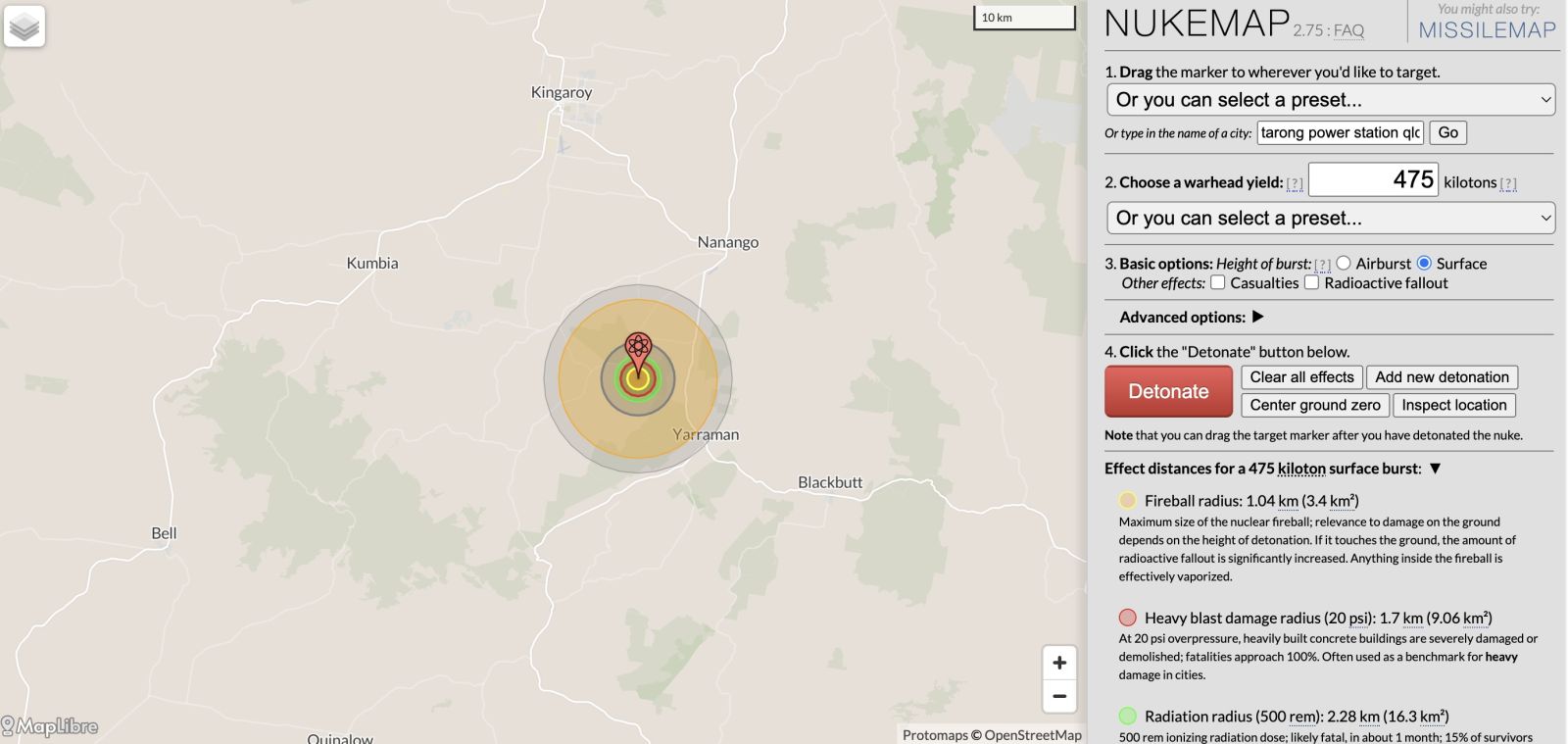
Callide QLD.:
Initial search suggests that Callide Power Station in QLD, is not currently in operation. The station experienced a structural failure in November 2022, which led to the shutdown of all four units. As of November 2022, all units were offline.
Worst-case scenario: A meltdown here will destroy the old Callide coal-fired power station site and this would be a direct hit which will take out Biloela (5,692 deaths), Kabra (103 deaths) and impact on Gracemere (12,023), Rockhampton (60,407), Gladstone (63,515). Previous meltdowns in Russia and Japan suggest that Brisbane (550 km away) (2,536,449) could be seriously impacted, but may not be that bad, depends, but we do know that the 150,000 living nearby are at serious risk.
Water availability: The power station was using water from the nearby Awoonga dam and Stag Creek Pipeline for cooling purposes. There is a nearby dam, Callide Dam, which is an earth and rock-fill dam constructed in 1965 to supply water for the Callide Power Station. The dam impounds Lake Callide, which holds 136,370 megalitres at an average depth of 10.5 metres and a surface area of 1,240 hectares at full capacity. Rockhampton is on the Fitzroy river. Gladstone is on the Calliope river. It seems that this could provide minimum requirements for potable water for ordinary operation and impact on key requirements for important QLD agriculture being conducted in the region would be minimal and in addition to all this in crisis mode sufficient saltwater from the sea to keep the system cool could be pumped uphill (240 metres above sea level) from the coast (102 km), at significant cost, but not enough to render this site unworkable, all of which means this is probably a goer.
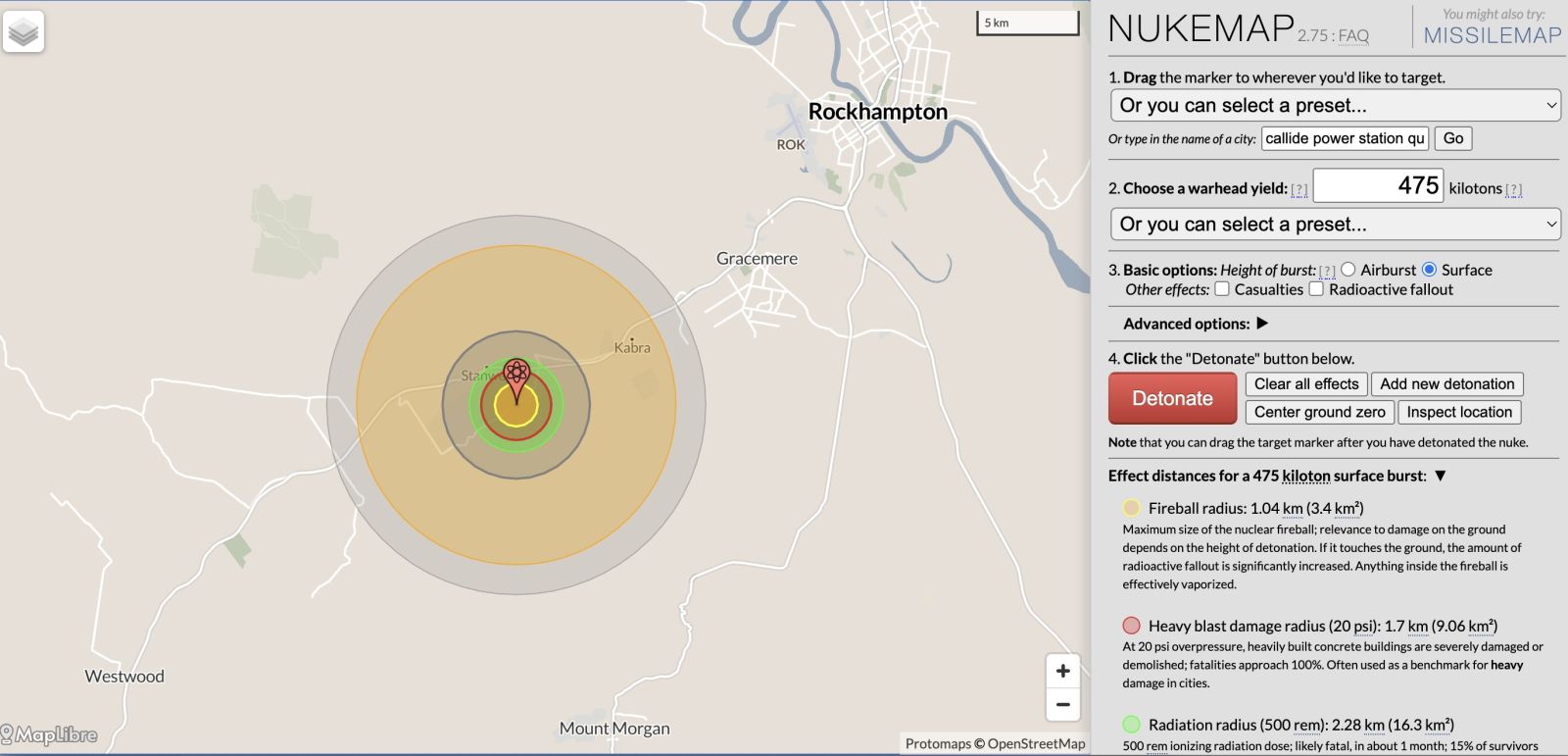
Port Augusta SA:
The Port Augusta Power Station, in South Australia, which comprised the Northern Power Station and Playford B Power Station, was closed on May 9, 2016. The power stations were demolished, and the site was rehabilitated, including the planting of saltbush cover over the ash pond. The site was sold to Cu-River Mining to develop a trans-shipping port for iron ore, grain, and other commodities. CU-River Mining acquired the former Northern Power Station site in Port Augusta, which is approximately the size of the Adelaide CBD. The company plans to build a port capable of handling iron ore, grain, and other commodities, which will create over 150 jobs in the region. The port project is a significant strategic decision for CU-River Mining, allowing the company to secure a direct export pathway for its high-grade iron ore magnetite.
Worst-case scenario: A meltdown here will be a direct hit to Port Augusta (13,515 deaths) the city's centre and surrounding suburbs, like Port Augusta West, is on the western side of the gulf on the Eyre Peninsula. With impact on Whyalla (21,742), Port Pirie (18,000), Wilmington (587), Melrose (6,987) etc. Previous meltdowns in Russia and Japan suggest that Adelaide (310 km away) (1,418,455) could be seriously impacted.
Water availability: The local region has virtually no potable water available to run this thirsty operation. That is to say Lake Augusta, White River and Savannah River may be attractive for locals and tourists wanting to have some fun but unless the whole operation, operating at sea level, is going to run on saltwater taken in from the sea, it is not a viable location. All of which means this idea is probably just Dutton desperately including it without any due consideration for the facts. Shows how limited his options truly were.
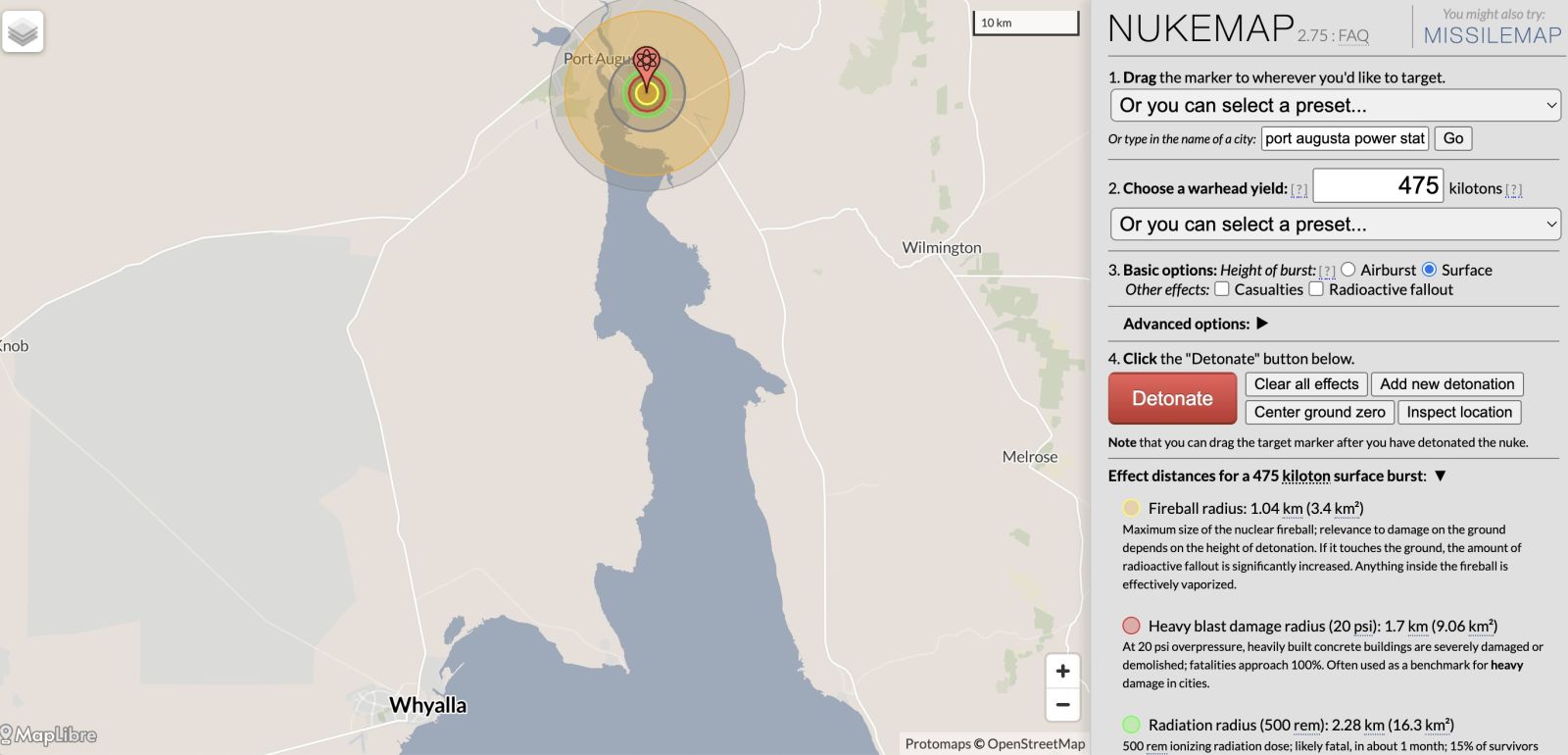
Collie WA:
The Collie Power Station in Western Australia was commissioned in 1999 and has been operational since then. Collie is scheduled to close by October 2027. The closure of the Collie Power Station is reportedly due to coal shortages and the increasing adoption of renewable energy sources.
Worst-case scenario: A meltdown here will impact on Bunbury (91,385), Harvey (30,795), Brunswick Junction (807), Boyanup (878), Dardanup (588), Capel (2,402), Donnybrook (2,822) etc. Previous meltdowns in Russia and Japan suggest that Perth (only 169 km away) (2,890,000) could be seriously impacted.
Water availability: The local region has lots of rivers and lakes, like Blackwood River: A significant river that flows through the city of Bunbury and is known for its water sports and fishing opportunities. Collie River: A river that flows through the nearby town of Collie and is popular for fishing and water sports. Capel River: A river that flows through the Ferguson Valley and is known for its natural beauty and water sports. Lake Clifton: A small lake located near the town of Lake Clifton, about 115 km south of Perth and 38 km southwest of Mandurah. It's a popular spot for fishing and boating. Bunbury Lake: A small lake located within the city of Bunbury, which is a popular spot for walking and picnicking. meaning potable water is available to run this thirsty operation, but how much it can deliver is not easy to understand at first glance. it may be a viable location. hard to know.
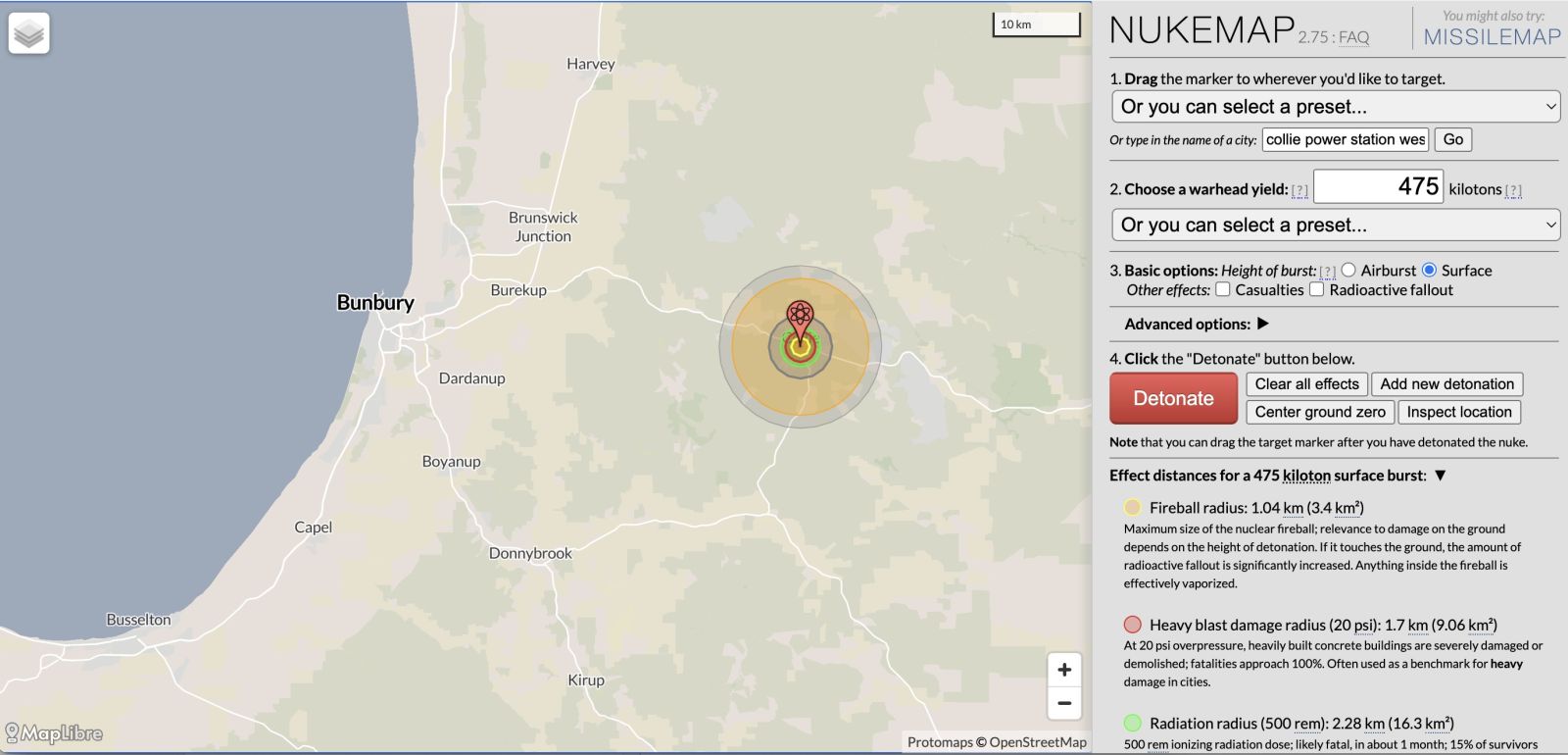
Conclusion: I've tried my hardest to make sense of a plan completely lacking in detail. But when you try to do that, it comes up wanting in any true meaning. It's hard to make a silk purse out of a sow's ear.

Comments
Steve Irons
Sun, 22/09/2024 - 11:31am
Permalink
Rex gives us some reality
Time to recognise the reality of ANZUS support for nuclear engagement https://x.com/MrRexPatrick/status/1837627051404341600
Steve Irons
Sun, 22/09/2024 - 10:58am
Permalink
Interesting use of the
Interesting use of the nuclear weapons map in today's nuclear debacle" https://michaelwest.com.au/us-australia-consequences-of-nuclear-war-with...
Add new comment